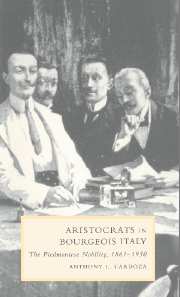Book contents
- Frontmatter
- Contents
- List of tables
- Acknowledgments
- Introduction
- 1 The making of the Piedmontese nobility: 1600–1848
- 2 The long goodbye: aristocrats in politics and public life: 1848–1914
- 3 Old money: the scale and structure of aristocratic wealth
- 4 Perpetuating an aristocratic social elite
- 5 The limits of fusion: aristocratic–bourgeois relations in nineteenth-century Piedmont
- 6 Retreat and adaptation in the twentieth century
- Bibliography
- Index
- CAMBRIDGE STUDIES IN ITALIAN HISTORY AND CULTURE
5 - The limits of fusion: aristocratic–bourgeois relations in nineteenth-century Piedmont
Published online by Cambridge University Press: 03 November 2009
- Frontmatter
- Contents
- List of tables
- Acknowledgments
- Introduction
- 1 The making of the Piedmontese nobility: 1600–1848
- 2 The long goodbye: aristocrats in politics and public life: 1848–1914
- 3 Old money: the scale and structure of aristocratic wealth
- 4 Perpetuating an aristocratic social elite
- 5 The limits of fusion: aristocratic–bourgeois relations in nineteenth-century Piedmont
- 6 Retreat and adaptation in the twentieth century
- Bibliography
- Index
- CAMBRIDGE STUDIES IN ITALIAN HISTORY AND CULTURE
Summary
As old juridical and institutional barriers disappeared in the course of the nineteenth century, the degree to which the aristocracy survived as an identifiably separate group at the upper reaches of Piedmontese society depended on more than recasting and reproducing traditional values, customs, and practices. It also entailed a restructuring of relations with other wealthy and influential non-noble elements who emerged to challenge the primacy of the old titled families within a new and greatly expanded ruling class. In this arena, aristocratic survival involved a mixture of flexibility and rigidity. From the stand point of the law, nobles had become only one among the various strata of the bourgeois world by the second half of the century. Moreover, changing political and economic realities in Piedmont and on the Italian peninsula necessitated an unprecedented level of cooperation and collaboration between nobles and non-nobles in virtually all areas of public life, especially after 1848. Rubbing elbows on elective municipal councils or on the boards of voluntary associations, however, did not automatically lead to more intimate connections in private life. On the contrary, the persistence of relatively closed social networks at least in Piedmont served to reinforce a caste consciousness and isolation that delayed genuine integration of old and new elites.
- Type
- Chapter
- Information
- Aristocrats in Bourgeois ItalyThe Piedmontese Nobility, 1861–1930, pp. 162 - 195Publisher: Cambridge University PressPrint publication year: 1998



